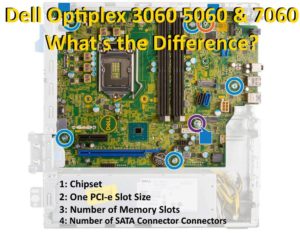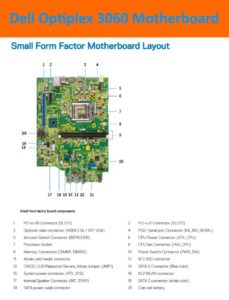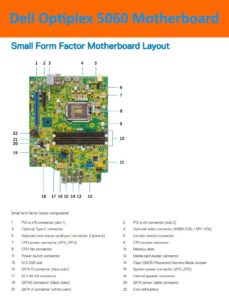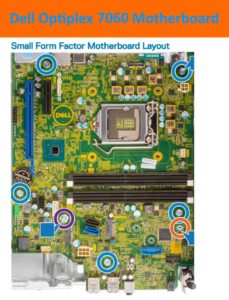If you want to buy a Dell corporate PC you are likely looking at the Optiplex line and finding it very difficult to figure out what the hardware differences are between their three offerings, the 3060, 5060 and 7060’s. All three of these lines:
- are offered in Mid-Tower, Small Form Factor (SFF) and Micro chassis
- support 8th Generation Intel CPU’s
- have USB 3.1 and USB Type C connectors
- support HDMI 1.4 (HDMI 2.0 optional) and DisplayPort 1.2
- do not support memory or CPU overclocking
- do not support “CrossFire” or SLI video
 Dell will only tell you that there are differences memory, CPU and video card offerings on each of the lines but will not explain what the underlying hardware differences are. Put simply the cheaper 3060 line has fewer options and the 7060’s have more options.
Dell will only tell you that there are differences memory, CPU and video card offerings on each of the lines but will not explain what the underlying hardware differences are. Put simply the cheaper 3060 line has fewer options and the 7060’s have more options.
If you are sourcing a 3060 that meets your specification, what are you not getting that is on the 5060’s or 7060’s? We blew a few hours and figured it out. The short answer is that the differences are mostly in marketing, but there are a few hardware differences you should be aware of:
Dell Optiplex 3060 vs 5060 vs 7060
The most notable difference between the 3060 line and the 5060/7060 is the chipset. The 3060 uses the slightly less capable Intel H370 chipset while the 5060 and 7060 use the Intel Q370 chipset. As you can see in the table below the only meaningful difference is that the 3060 with H370 chipset does NOT support Intel vPro management, which most companies like but will not pay extra for.
UPDATE: OCT 2018 – After placing orders for all Opti 3060, 5060, and 7060’s we also found that all Optiplex 3060 have one HDMI head. This means it is not possible to get 3 DisplayPort heads on a 3060. 3 DisplayPort heads are not a problem on the 5060 or 7060’s.
To keep this comparison table clean, we have listed the features available on the Dell Optiplex 3060 in the left column and then noted only the differences in the Optiplex 5060 and Optiplex 7060 columns:
| Dell Optiplex 3060 SFF | Dell Optiplex 5060 SFF | Dell Optiplex 7060 SFF |
| Intel H370 Chipset | Intel Q370 Chipset | Intel Q370 Chipset |
| Intel vPro Not Capable | Intel vPro Optional | Intel vPro Optional |
| Intel Pentium Gold, Core i3, Core i5 | Core i5 or Core i7 | Core i5 or Core i7 |
| 16GB Max from Dell but 32GB Max aftermarket | 64GB Max | 64GB Max |
| 3.5″ or 2.5″ SATA Hard Disk SSD or Spinning | ||
| M.2 PCIe SSD Option – need nut clip to screw it down | ||
| Integrated Video, nVidia GT730, AMD R5 430 & RX 550 | Integrated or AMD | Integrated or AMD |
| Tower/Small Form Factor | ||
| No Thunderbolt Option | Thunderbolt Add On Available | |
| 2 SATA Connectors | 3 SATA Connectors | 3 SATA Connectors |
| 1 PCI Express 16x Slot | ||
| 1 PCI Express 1x Slot | 1 PCIe 4x Slot | 1 PCIe 4x Slot |
| 2 Memory Slots | 4 Memory Slots | 4 Memory Slots |
| 1 x USB 3.1 Gen 2 (Type-C) | ||
| 5 x USB 3.1 Gen 1 (1 Type-A front/4 Type-A rear) | ||
| 4 x USB 2.0 (2 Type-A front/2 Type-A rear – 1 front with PowerShare) | ||
| 1 RJ-45 | ||
| 1 Serial | ||
| 2 DisplayPorts 1.2 | ||
| PS/2 (Optional – I have not seen any with PS2 ports) | ||
| 1 UAJ (Universal Audio Jack) | ||
| 1 Line-out | ||
| 1 VGA (Optional) | ||
| 1x 3rd DisplayPort (Optional) | ||
| 1 HDMI 2.0b (Optional) | ||
| 1 USB Type-C Alt Mode (Optional) | ||
| 1 M.2 for storage (22x80mm / 22x30mm) | ||
| 1 M.2 for wireless (22x30mm) | ||
| Tower | ||
| 1 internal 3.5” HDD | ||
| 2 internal 2.5” HDD/SSD | ||
| 1 internal slim ODD | ||
| 260W typical 85% Efficient PSU (80 PLUS Bronze) ENERGY STAR compliant, Active PFC | ||
| 260W typical 92% Efficient PSU (80 PLUS Platinum); ENERGY STAR compliant, Active PFC | ||
| Small Form Factor | ||
| 1 x 3.5” HDD or 2 x 2.5” HDD/SSD | ||
| 1 internal slim ODD | ||
| 200W typical 85% Efficient PSU (80 PLUS Bronze) ENERGY STAR compliant, Active PFC | ||
| 200W typical 92% Efficient PSU (80 PLUS Platinum); ENERGY STAR compliant, Active PFC | ||
| Environmental Standards (eco-labels) | ||
| ENERGY STAR | ||
| EPEAT Registered* | ||
| TCO Certified | ||
| CEL | ||
| WEEE | ||
| Japan Energy Law | ||
| South Korea E-standby | ||
| South Korea Eco-label | ||
| EU RoHS | ||
| China RoHS* | ||
| Warrenty | ||
| 3 Years Hardware Service with Onsite/In-Home Service After Remote Diagnosis | ||
| ProSupport Available as an Option |
Intel 8th Generation Chipset Specifications:
| Chipset | Z370 | H370 Dell Opti3060 | Q370 Dell Opti5060/7060 | B360 | H310 |
| Market | Consumer | Consumer/Corporate | Corporate | Consumer/Corporate | Consumer |
| Maximum HSIO lanes | 30 | 30 | 30 | 24 | 14 |
| Overclocking | Yes | No | No | No | No |
| Max. USB 3.1 (Gen 1) | 10 | 10 | 8 | 6 | 4 |
| Max. USB 3.1 (Gen 2) | – | 4 | 6 | 4 | 0 |
| Max. SATA 6Gbps | 6 | 6 | 6 | 6 | 4 |
| PCH PCIe 3.0 lanes | 24 | 20 | 24 | 12 | – |
| PCH PCIe 2.0 lanes | – | – | – | – | 6 |
| Max. Intel RST for PCIe storage | 3 | 2 | 3 | 1 | 0 |
| Intel Optane Memory support | Yes | Yes | Yes | Yes | No |
| Integrated Intel Wireless-AC | No | Yes | Yes | Yes | Yes |
| Intel Smart Sound | Yes | Yes | Yes | Yes | No |
| Intel vPro | No | No | Yes | No | No |
| TDP | 6W | 6W | 6W | 6W | 6W |
If you want even more detail you will find the Dell service manuals to be helpful:






7 Comments
Arne Freitag · January 23, 2020 at 8:36 am
The Optiplex 5060 has no RAID option, the 7060 will support RAID 0+1. The Optiplex 7060 has PS/2 keyboard and mouse connectors and also RS232 onboard.
strikematch13 · August 19, 2019 at 10:01 am
Thanks for digging in and posting this. I’ve always struggled to find the difference and wondered why not buy the 3000 series. I will also mention that the 7000 series has historically had an old school PCI slot (not express) on the motherboard, while the 3000 series did not. I can’t say for sure on the latest models but just something to be aware of if you have an old style PCI card
adonics · August 13, 2019 at 2:40 am
Dell Optiplex 7070 micro still can’t use m2 pcie 3.0 x4, the max READ speed is 1800
Ab · July 19, 2019 at 6:17 pm
One meaningful difference is that the bandwidth of NVME storage devices using the M.2 slot is limited in the 3060/5060 . i.e. you get PCIe 2.0 spec x 4 lanes instead of PCIe 3.0 x 4 lanes – half the speed. So if disk performance is very important then choose the 7060.
see: https://www.dell.com/community/Optiplex-Desktops/Optiplex-3060-SAMSUNG-970-EVO-PCIe-2-0-x-4/td-p/6133644/page/3
quote “..it’s a hardware limitation of both the Optiplex 3060 and 5060 – they used “scaled down” versions of the Intel chipsets that limit their ability to hit the specifications of the NVMe PCIe 3.0 x4 bus. Essentially they have a fully-featured H370/Q370 chipset for the CPU/Memory bus, but a “scaled down” PCI 2.0 design for the system bus.
So that means CPU and memory benchmarks will be consistent with other PCs, but overall NVMe performance is shaved in half.”
fany · February 17, 2019 at 8:01 am
thank you for your info it’s so helpfull.
but what is difference between 5060 and 7060 series?
because they’re look so same with the same capability & specs
Ian Matthews · February 27, 2019 at 8:02 pm
The 5060 and 7060 are NEARLY identical and it comes down to details most people/conmpanies will not care about. In my case I have to buy 7060’s because I could not get 5060’s with 3 Display Port heads.
Note that Dell is week away from releasing the new 3070, 5070 and 7070 line with the latest Intel CPU’s and that Dell also just re-released their VOSTRO line. Vostro’s look and feel like 3050’s (3060’s, 3070’s) so they have limitations like not having the option for 3 DisplayPort heads and I don’t THINK any of them have Intel vPro (could be wrong on that).
xx · December 17, 2018 at 1:05 pm
Dell OptiPlex 7060 SFF Motherboard layout
http://s306.photobucket.com/user/jurasea/media/My_Dell-7060-SFF-MB.jpg.html